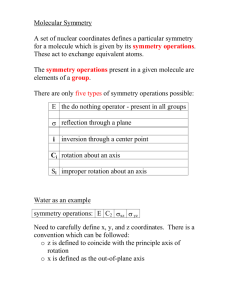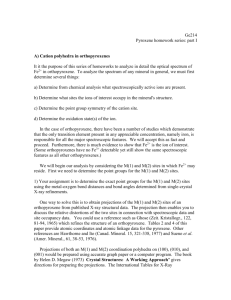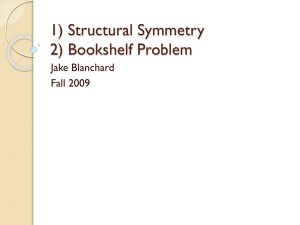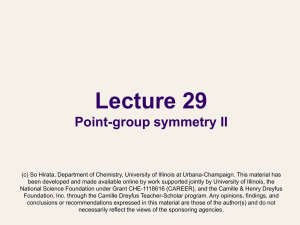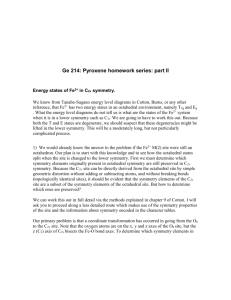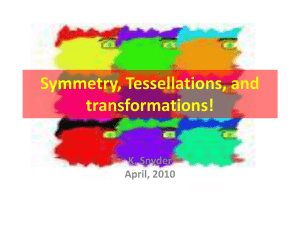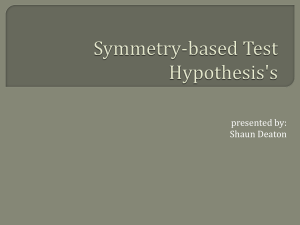group theory for mathematiciansx
advertisement
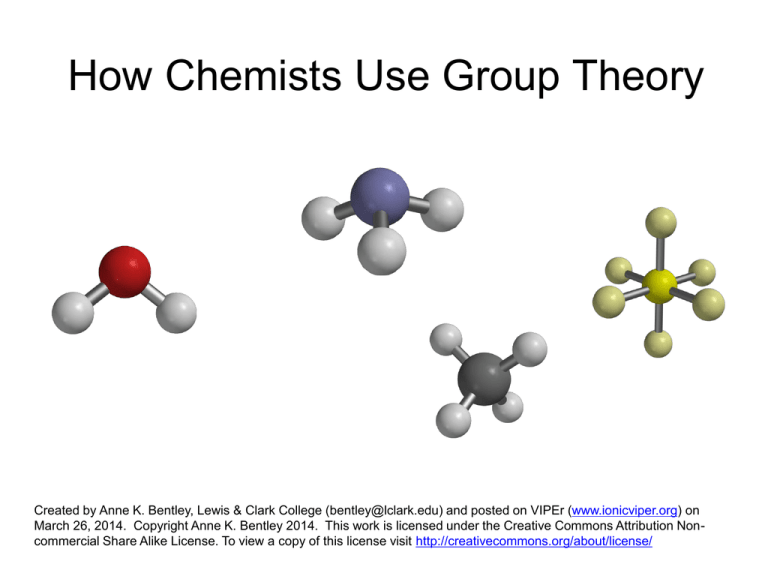
How Chemists Use Group Theory Created by Anne K. Bentley, Lewis & Clark College (bentley@lclark.edu) and posted on VIPEr (www.ionicviper.org) on March 26, 2014. Copyright Anne K. Bentley 2014. This work is licensed under the Creative Commons Attribution Noncommercial Share Alike License. To view a copy of this license visit http://creativecommons.org/about/license/ Why do chemists care about symmetry? It allows the prediction of • chirality • IR and Raman spectroscopy • bonding Which objects share the same symmetry as a water molecule? How can we “quantify” symmetry? Symmetry can be described by symmetry operations and elements. • rotation, Cn • reflection, σ • inversion, i • improper rotation, Sn • identity, E Objects that share the same set of symmetry elements belong to the same point group. = C2v (E, C2, two σv) The operations in a group follow the requirements of a mathematical group. • Closure • Identity if AB = C, then C is also in the group • Associativity • Reciprocality The operations in a group follow the requirements of a mathematical group. • • • • Closure Identity Associativity Reciprocality AE = EA = A The operations in a group follow the requirements of a mathematical group. • • • • Closure Identity Associativity Reciprocality (AB)C = A(BC) The C2v point group is an Abelian group – ie, all operations commute (AB = BA). Most point groups are not Abelian. The operations in a group follow the requirements of a mathematical group. • • • • Closure Identity Associativity Reciprocality AA-1 = E In the C2v point group, each operation is its own inverse. The operations in a group follow the requirements of a mathematical group. • • • • Closure Identity Associativity Reciprocality Each operation can be represented by a transformation matrix. é –1 ê ê 0 êë 0 0 0 –1 0 0 1 ù ú ú úû transformation matrix éxù ê ú y ê ú êë z úû original coordinates = é ê ê êë –x –y z ù ú ú úû new coordinates Which operation is represented by this transformation matrix? The transformation matrices also follow the rules of a group. é –1 ê ê 0 êë 0 0 0 –1 0 0 1 C2 ùé úê úê úû êë 1 0 0 0 –1 0 0 0 1 σxz ù é –1 ú ê 0 = ú ê úû êë 0 0 0 1 0 0 1 σyz ù ú ú úû Irreducible representations can be generated for x, y, and z C2v σv(xz) σv(yz) E C2 1 –1 1 –1 x 1 –1 –1 1 y 1 1 1 1 z A complete set of irreducible representations for a given group is called its character table. C2v σv(xz) σv(yz) E C2 1 –1 1 –1 x 1 –1 –1 1 y 1 1 1 1 z ? A complete set of irreducible representations for a given group is called its character table. C2v σv(xz) σv(yz) E C2 1 –1 1 –1 x 1 –1 –1 1 y 1 1 1 1 z 1 1 –1 –1 xy More complicated molecules… ammonia, NH3 C3v methane, CH4 Td Applications of group theory • IR spectroscopy • Molecular orbital theory Gases in Earth’s atmosphere nitrogen (N2) 78% oxygen (O2) 21% argon (Ar) carbon dioxide (CO2) 0.93% 400 ppm (0.04%) carbon dioxide stretching modes not IR active IR active Are the stretching modes of methane IR active? Td E 8C3 3C2 Γ 4 1 0 Γ = A1 + T2 6S4 6σd 0 2 methane’s A1 vibrational mode not IR active methane T2 stretching vibrations • all at the same energy • T2 irreducible rep transforms as (x, y, z) • together, they lead to one IR band Molecular Orbital Theory How and why does something like this form? Bonding Basics • Atoms have electrons • Electrons are found in orbitals, the shapes of which are determined by wavefunctions Bonding Basics • A bond forms between two atoms when their electron orbitals combine to form one mutual orbital. + + = = Bonding is Determined by Symmetry + + + = no bond forms = bond forms = bond forms Use group theory to assign symmetries and predict bonding. A1g T1u (and two more) SF6 and T2g Eg Outer atoms are treated as a group. A1g T1u Eg Which types of bonds will form? central sulfur six fluorine A1g A1g T1u T1u T2g Eg Eg Concluding Thoughts Recommended Resources Cotton, F. Albert. Chemical Applications of Group Theory, Wiley: New York, 1990. Carter, Robert L. Molecular Symmetry and Group Theory, Wiley: 1998. Harris, Daniel C. and Bertolucci, Michael D. Symmetry and Spectroscopy, Dover Publications: New York, 1978. Vincent, Alan, Molecular Symmetry and Group Theory, Wiley: New York, 2001. http://symmetry.otterbein.edu Please return your office supplies!
